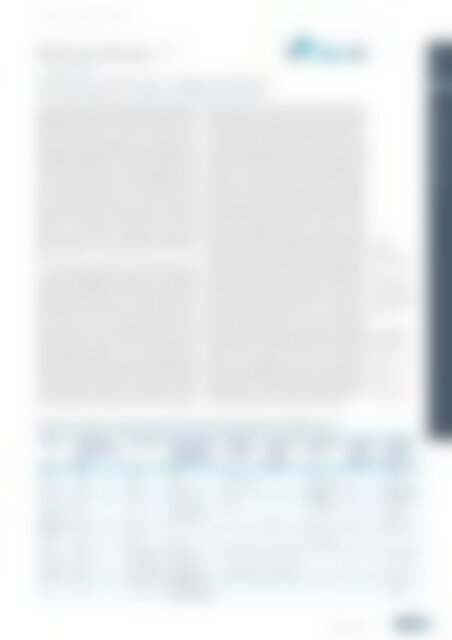atw - International Journal for Nuclear Power | 10.2020
Description Ever since its first issue in 1956, the atw – International Journal for Nuclear Power has been a publisher of specialist articles, background reports, interviews and news about developments and trends from all important sectors of nuclear energy, nuclear technology and the energy industry. Internationally current and competent, the professional journal atw is a valuable source of information. www.nucmag.com
Description
Ever since its first issue in 1956, the atw – International Journal for Nuclear Power has been a publisher of specialist articles, background reports, interviews and news about developments and trends from all important sectors of nuclear energy, nuclear technology and the energy industry. Internationally current and competent, the professional journal atw is a valuable source of information.
www.nucmag.com
You also want an ePaper? Increase the reach of your titles
YUMPU automatically turns print PDFs into web optimized ePapers that Google loves.
<strong>atw</strong> Vol. 65 (2020) | Issue 10 ı October<br />
Did you know...?<br />
No Harm to the Environment – Progress and Solutions<br />
in the Management of High-level Radioactive Waste<br />
Recently the <strong>Nuclear</strong> Energy Agency (NEA) of the OECD published<br />
the Report Radioactive Waste Management 2020 with the title<br />
“Management and Disposal of High-Level Radioactive Waste:<br />
Global Progress and Solutions”. The report is characterized by the<br />
NEA as a policy-level compendium of the current status of<br />
knowledge, technological developments, safety standards, rules<br />
and requirements applicable to evaluating the feasibility of DGRs<br />
(=Deep Geological Repositories). It summarises how the international<br />
scientific community has intensively collaborated to bring<br />
sound arguments and evidence into the debate that SNF/HLW<br />
will not cause harm to either humans or the environment. In this<br />
sense the report relates directly to the current European policy<br />
debate about the evaluation of nuclear energy as a sustainable<br />
low-carbon contributor to the mitigation of climate change or as<br />
harmful to the environment as was pointed out by the NEA<br />
Director- General, Mr William D. Magwood, IV during a NEAwebinar.<br />
(see also the article “Sustainable Finance Initiative of<br />
the EU and Taxonomy – How green is <strong>Nuclear</strong>?” in this issue of<br />
<strong>atw</strong>)<br />
In its arguments the NEA points to the long tradition of radiation<br />
protection dating back to the creation of the <strong>International</strong><br />
Commission on Radiological Protection (ICRP), an independent<br />
nongovernmental organisation in 1928 to advance the science of<br />
radiological protection and some 70 year of scientific investigation<br />
and research concerning nuclear waste management. The<br />
ICRP (1998) recommends a maximum radiation exposure of not<br />
more than 0.3 mSv per year <strong>for</strong> people living near the DGR<br />
( Germany requires 0.1 mSv <strong>for</strong> unlikely and 0.01 mSv <strong>for</strong> likely<br />
developments of the DGR). The annual global average dose from<br />
natural background radiation is 2.4 mSv. Concerning the EU/<br />
Euratom, the NEA reminds of the first Basic Safety Standard (BSS)<br />
Directive that was adopted in 1959 to ensure the highest possible<br />
protection of workers and members of the public from exposure<br />
to ionising radiation. The Directive has been amended regularly<br />
and the most recent BSS Directive was adopted in 2014. Concerning<br />
management of nuclear waste at EU level, the Euratom<br />
Waste Directive (Council Directive 2011/70/ EURATOM of 19 July<br />
2011 establishing a Community framework <strong>for</strong> the responsible<br />
and safe management of spent fuel and radioactive waste) refers<br />
to the Euratom Basic Safety Standards <strong>for</strong> Radiation Protection.<br />
Besides regulation the report shows that from the early days<br />
of commercial nuclear power some 70 years ago, the nuclear<br />
sector has responsibly addressed the life cycle of its materials and<br />
their impacts, including the use of advanced technology <strong>for</strong> waste<br />
management. In all cases i.e. whether spent nuclear fuel (SNF) is<br />
recycled or not, the final disposal of the high-level radioactive<br />
waste (HLW) has been a matter requiring attention. Policy makers<br />
and scientists at the national and international level have been<br />
proposing, studying and implementing the safe disposal of SNF/<br />
HLW. The NEA report demonstrates that the scientific consensus<br />
today, that has developed <strong>for</strong> more than a half century, is that<br />
DGRs are a safe and effective approach to permanently dispose<br />
of SNF/HLW. Independent national regulators have endorsed<br />
their effectiveness to isolate SNF/HLW from humans and the<br />
environment and the safety principles and technological solutions<br />
<strong>for</strong> the long-term management of SNF/HLW are well established.<br />
The NEA also points out that the effective and decades long<br />
implementation of safe interim storage in respect of all regulatory<br />
requirements concerning radiation protection, safety, security<br />
and non-proliferation has granted experts the time necessary to<br />
develop robust technical solutions within a democratic and<br />
transparent decision-making process <strong>for</strong> the final management<br />
of SNF/HLW without the need to rush to disposal. To this end<br />
underground research laboratories (URL) have been constructed<br />
and operated and in situ experiments per<strong>for</strong>med and replicated<br />
in many locations. As a result, there is now a robust basis <strong>for</strong> the<br />
design and constructability of safe DGRs. The accumulated<br />
scientific results, technological evidence and safety demonstrations<br />
have been presented openly and were critically reviewed by<br />
internationally recognised experts to reach the current level of<br />
maturity. Below you can find a table showing the timeline <strong>for</strong><br />
countries further along in the DGR process <strong>for</strong> SNF/HLW.<br />
Source:<br />
Radioactive Waste<br />
Management 2020<br />
Management and<br />
Disposal of High-Level<br />
Radioactive Waste:<br />
Global Progress and<br />
Solutions, OECD 2020,<br />
NEA No. 7532<br />
For further details<br />
please contact:<br />
Nicolas Wendler<br />
KernD<br />
Robert-Koch-Platz 4<br />
10115 Berlin<br />
Germany<br />
E-mail: presse@<br />
KernD.de<br />
www.KernD.de<br />
DID YOU EDITORIAL KNOW...?<br />
473<br />
Timeline <strong>for</strong> countries further along in the Deep Geological Repositories (DGR) process<br />
Country Feasibility and<br />
site investigations<br />
begin<br />
Site selected<br />
Begin construction<br />
of underground<br />
Rock Laboratory<br />
Application<br />
submitted<br />
Construction<br />
license<br />
granted<br />
Construction<br />
begin<br />
Total years<br />
prior to<br />
application<br />
Projected<br />
operational<br />
period<br />
Finland 1983 2000 2004 2012 2015 2016 29 100 years<br />
France 1991 1998 2000 2021 (estimate) 2022 (estimate) 30 100 years<br />
Sweden 1976 2009 1990 (Äspö) 2011 Early 2020s<br />
(estimate)<br />
United States<br />
(Yucca)<br />
United States<br />
(WIPP)<br />
1982 1987 1993 (Exploratory<br />
Studies Facility)<br />
34 45 years (routine<br />
operation)<br />
2008 2048 (estimate) 28 100 years or<br />
longer<br />
1955 1974 1979 1981 24 35 years<br />
China 1985 2018 2020 2041 (estimate)<br />
Canada 1978 2023 (estimate) 1982 (AECL) 2028 (estimate) 2032 (estimate) 50 40 years or more<br />
Germany 1965 2031 (estimate) 1986 (Gorleben)<br />
Switzerland 1978 2022 (estimate) 1984 (Grimsel)<br />
1996 (Mont Terri)<br />
Japan 1976 2027 (estimate) 2002 (Mizunami URL)<br />
2005 (Horonobe URL)<br />
2024 (estimate) 2031 (estimate) 46 ~ 30 years<br />
~ 50 years<br />
Did you know...?

















